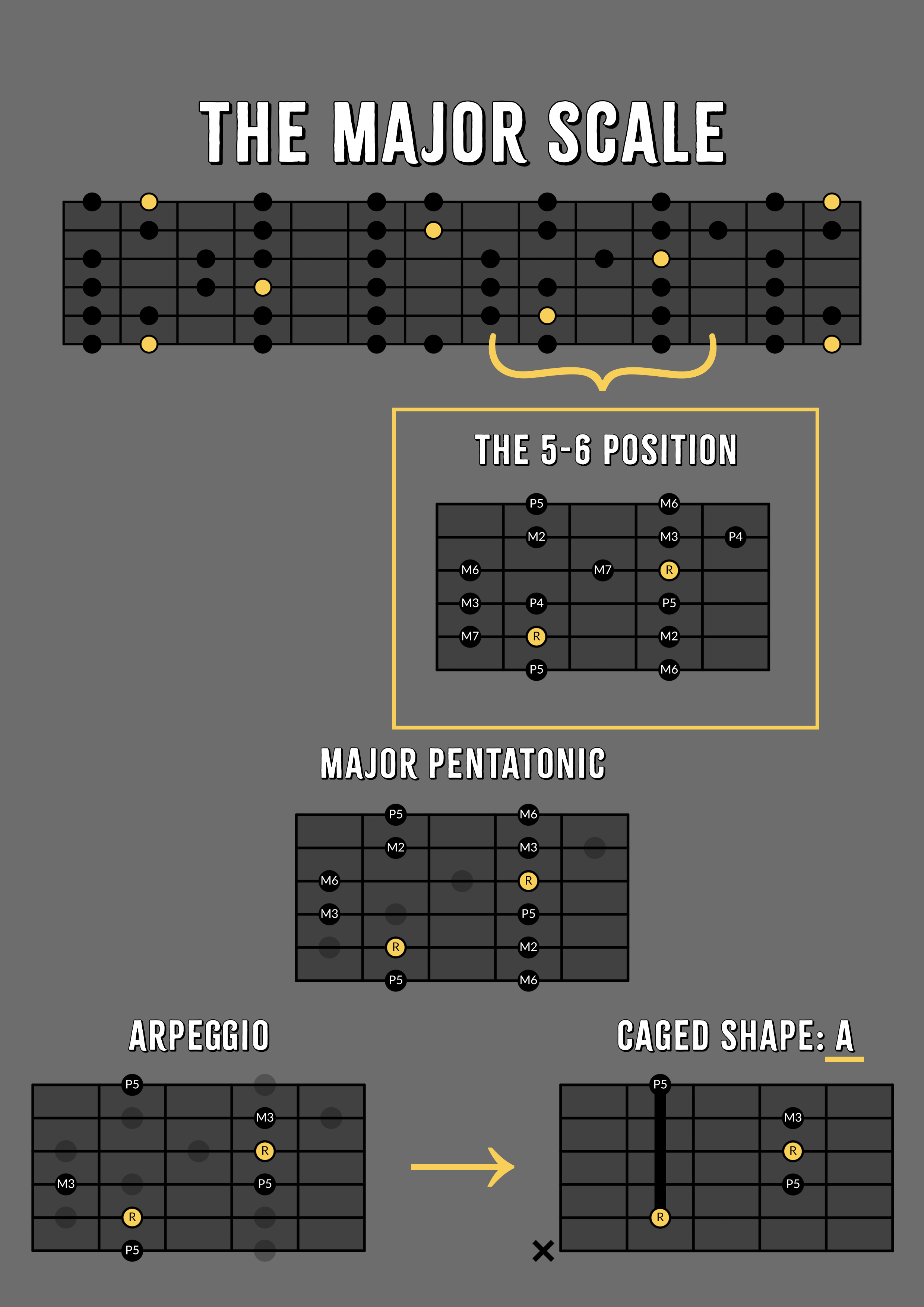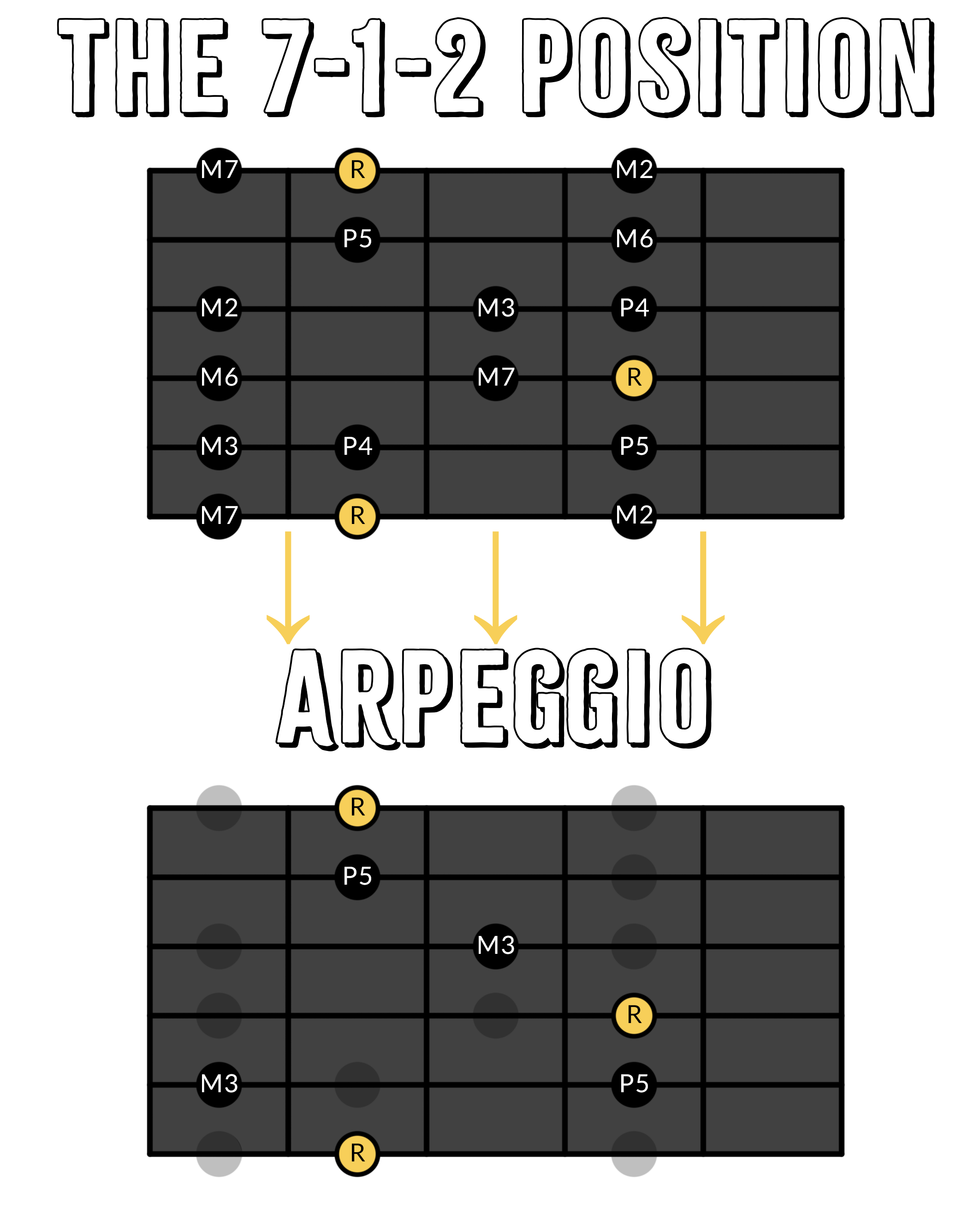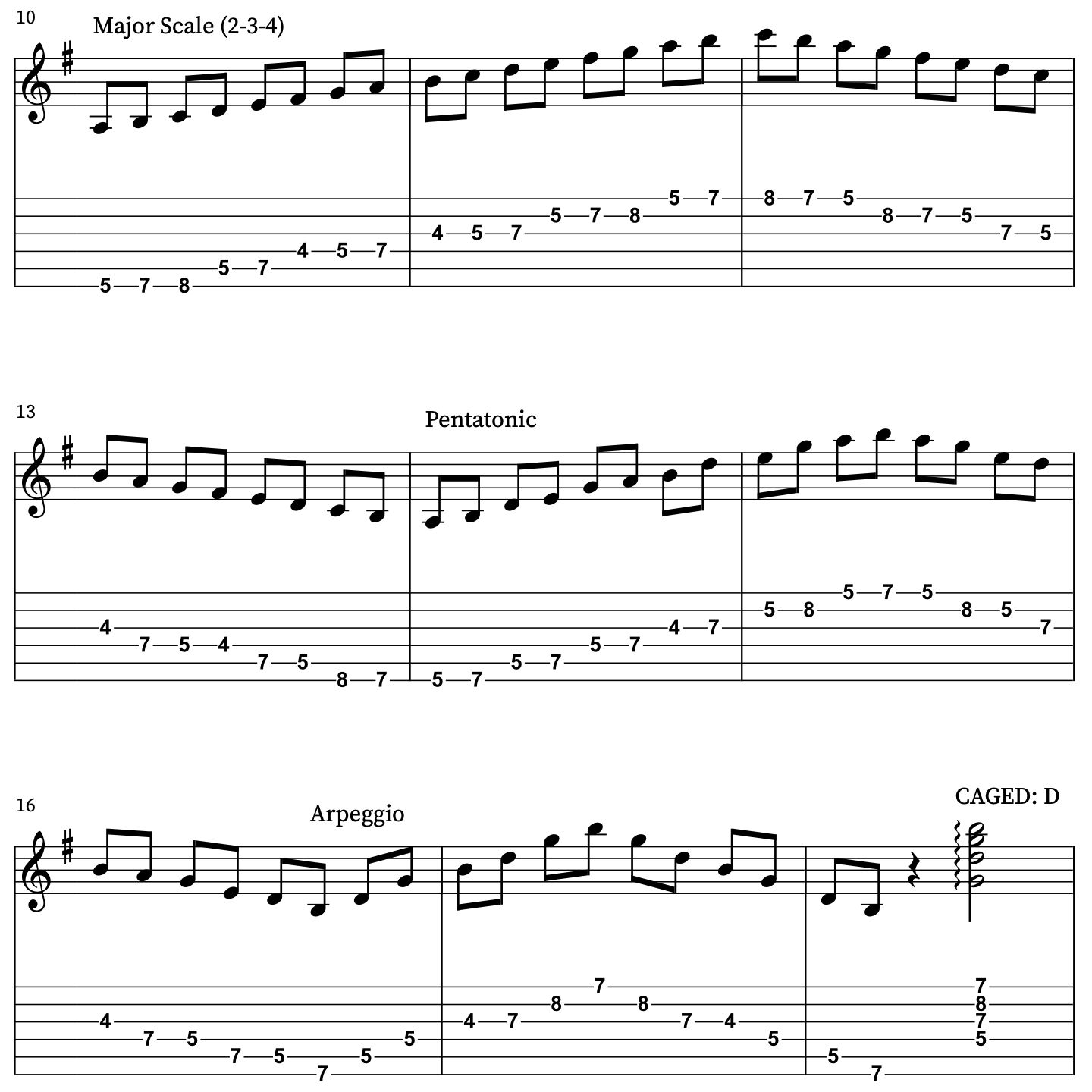Where to Begin?
Learning the fretboard can feel overwhelming—even for experienced players. That’s why our first step is to break everything up and learn it piece by piece.
If anything in the diagram looks familiar, you may already know parts of the pentatonic scale—one of the most popular scales for guitarists. The pentatonic scale is closely related to the major scale, which has seven notes. The pentatonic simply removes two notes, leaving five (hence "penta"-tonic). [Figure 1]
How to Approach Learning These Scales:
If you already know the pentatonic scale, start by memorizing its five shapes. Once comfortable, you’ll add the two missing notes back in to form the full major scale after.
If you don’t know the pentatonic scale yet, start with the full major scale first. Once you master that, learning the pentatonic scale will feel easier.
Figure 1:
Understanding the Diagram
There are five positions of the major scale. [Figure 2] Each position is named based on the scale degrees found on the E strings:
7-1-2
2-3-4
3-4-5
5-6
6-7-1
These names will help you locate any major scale position in any key. For example, in G major, where 7-1-2 = F#-G-A, the position starts on the 2nd, 3rd, and 5th frets of the low E string.
Instead of note names, the diagram uses intervals relative to the tonic (Root, M2, M3, P4, P5, M6, M7). This helps you apply the pattern to any key.
Figure 2:
Learning the Full Major Scale Positions
Step 1: Play & Internalize
Pick a key to start with—G major is a great choice because it’s easy to visualize on the fretboard and only has one sharp (F#).
Start with the 7-1-2 position [Figure 3] and play it slowly, ascending and descending. [Figure 4]
Use a 40-60 bpm metronome and play in quarter notes.
Try singing along using solfege (Do Re Mi…) or numbers (1 2 3…). This helps you internalize the scale.
Step 2: Recognize Patterns
Each position contains at least one full octave.
Each position has one string with only two notes instead of three (this changes in each position). In the 7-1-2, it’s the B string. In the 5-6, it's both E strings.
Think about the actual notes being played in each position. Where are the half steps? Where’s the tonic?
Step 3: Apply & Improvise
Find a backing track (e.g., search "G major backing track" on YouTube).
Play the scale in rhythm with quarter or eighth notes.
Experiment with different note combinations—listen for what sounds good!
Step 4: Transpose & Change Positions
Same position, different key: Move the 7-1-2 position to another key, like Eb major. It’s the same pattern, but try to think about the notes being played.
Different position, same key: Once you’ve mastered the 7-1-2, learn the 2-3-4 [Figure 5] in G major (where 2-3-4 = A-B-C) the same way you learned the previous position. When comfortable, connect the two positions.
Figure 3:
Figure 4:
Figure 5:
Learning the Pentatonic Scale
To form the major pentatonic scale, remove the 4th (P4) and 7th (M7) from the full major scale. You’ll be left with five notes: Root, M2, M3, P5, M6. [Figure 6]
Follow the same learning process:
Start with the 7-1-2 pentatonic position.
Play it slowly, then improvise along with a backing track.
Once comfortable, you can add back the missing 4ths and 7ths to create the full scale.
After you feel confident with the 7-1-2, do the same with the other four positions.
This approach keeps the spacious, open sound of the pentatonic while still allowing for more expressive note choices from the major scale, giving you better control of your sound.
Figure 6:
Learning Arpeggios
Once you know all five major scale positions and their pentatonic modifications, the next step is to learn arpeggios.
To build a major arpeggio for our tonic chord, play only the Root (R), Major 3rd (M3), and Perfect 5th (P5) from the major scale patterns. [Figure 7]
Try singing along (e.g., Do Mi Sol Do or 1 3 5 1) to reinforce the sound.
Notable Pattern:
Each position has one string with two chord tones instead of one (this changes in each position). In the 7-1-2, it’s the A string. In the 3-4-5, it's both E strings.
Figure 7:
Understanding the CAGED System
Once you’ve learned arpeggios, you’ll start recognizing CAGED chord shapes within them. The CAGED system divides the fretboard into five overlapping chord shapes, based on familiar open chords (C, A, G, E, D).
How CAGED Shapes Work:
Any major chord can be played using five different shapes. [Figure 8]
Example: A C major chord can be played in the C, A, G, E, or D shape at different fretboard positions.
You’ve likely already used this idea: A barre chord is just a movable E or A shape!
Applying CAGED to the Major Scale:
Each CAGED shape aligns with one of the five major scale positions. [Figure 9]
Some shapes are difficult to play fully, but even partial versions can be useful.
Example: The G shape in the 6-7-1 position is tricky as a full chord, but a D-string-rooted voicing works well.
Notable Patterns:
Each position overlaps where the root (R) is located.
Knowing where the root note is located in each of these shapes will help you find chords faster.
Figure 8:
Figure 9:
Using the Major Scale as a Lens
Now that you’ve learned:
✔ Five major scale positions
✔ How to modify them into pentatonic scales
✔ How to extract arpeggios
✔ How to find CAGED chord shapes within them
You can see how all these concepts interconnect:
The full scale contains all 7 notes.
The pentatonic scale removes 4ths and 7ths.
The arpeggio removes 2nds and 6ths.
The CAGED system helps visualize chord tones within the scale.
Mastering these relationships will unlock the fretboard and make you a more confident, creative player.
Scroll down to view some helpful exercises…
Lizard CAGED Exercise in C
*Challenge: Try to transpose this exercise and play in other keys!
Full Lizard Exercise in G
1.)
2.)
3.)
4.)
5.)
*Challenge: Try to transpose this exercise and play in other keys!
















